Strategic Management Report: Knowledge Systems and Implementation
VerifiedAdded on 2021/01/02
|10
|2300
|142
Report
AI Summary
This report delves into the realm of strategic management, examining the crucial role of business information systems in supporting managerial decisions across strategic, tactical, and operational levels. It elucidates how these systems empower organizations to achieve a strategic advantage over competitors through models like Porter's competitive forces and the value chain. Furthermore, the report explores the benefits of knowledge management systems within an organization, emphasizing their contribution to enhanced decision-making, efficient information dissemination, and innovation. It also addresses the key challenges that management faces when implementing knowledge information systems, such as evaluating knowledge, keeping up with technology, motivating employees, and managing data redundancy. The report concludes by highlighting the significance of information systems in fostering effective strategic management practices.

Strategic Management
Paraphrase This Document
Need a fresh take? Get an instant paraphrase of this document with our AI Paraphraser

Table of Contents
INTRODUCTION...........................................................................................................................1
TASK 1............................................................................................................................................1
(a) Use of business information system to support managerial decision of organisation...........1
(b) Information system help organisation to achieve strategic advantage over its competitors. 2
TASK 2............................................................................................................................................3
(a) Benefits of knowledge management system in an organisation............................................3
(b) The key issues facing management when implementing knowledge information-system in
organisation.................................................................................................................................5
INTRODUCTION...........................................................................................................................1
TASK 1............................................................................................................................................1
(a) Use of business information system to support managerial decision of organisation...........1
(b) Information system help organisation to achieve strategic advantage over its competitors. 2
TASK 2............................................................................................................................................3
(a) Benefits of knowledge management system in an organisation............................................3
(b) The key issues facing management when implementing knowledge information-system in
organisation.................................................................................................................................5
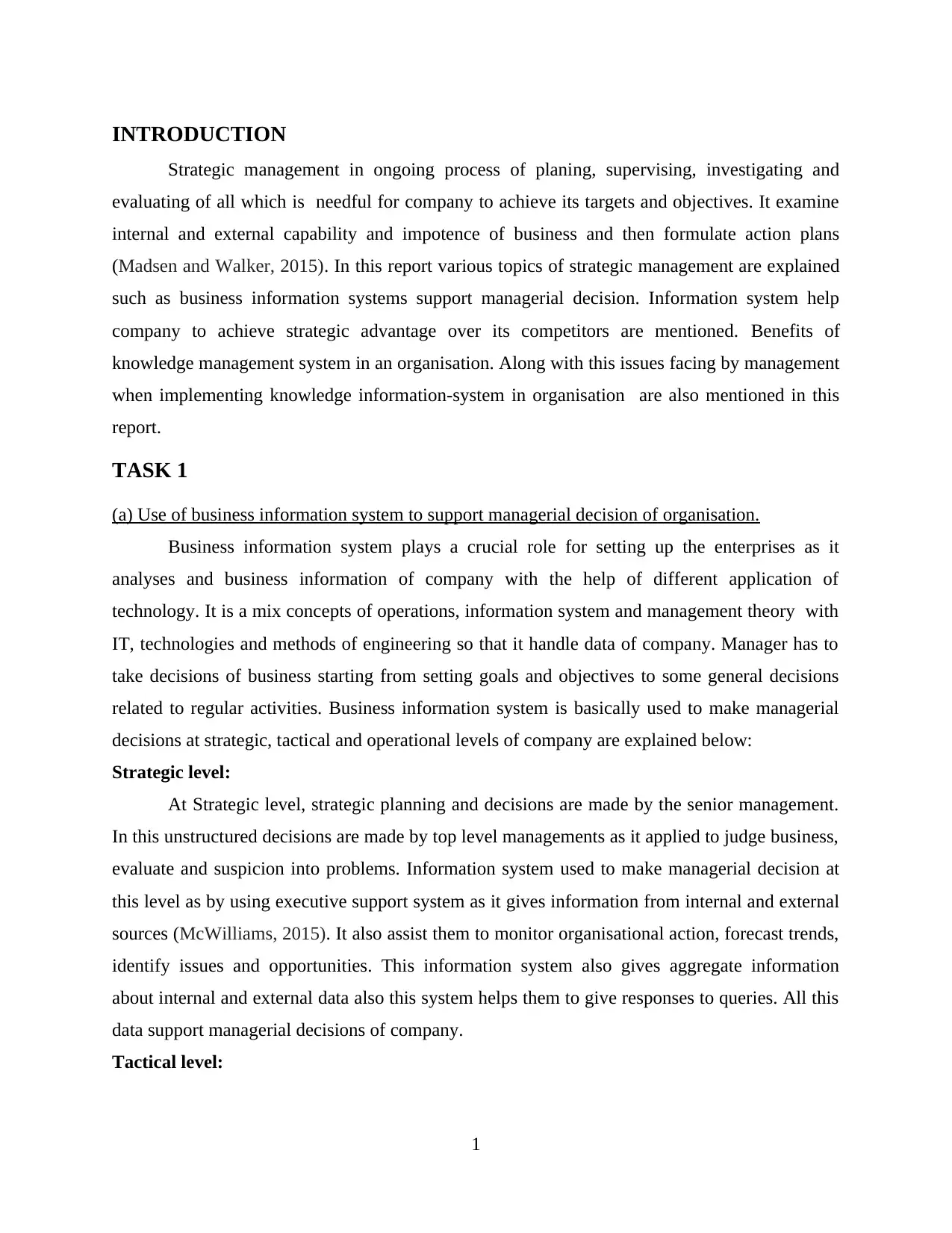
INTRODUCTION
Strategic management in ongoing process of planing, supervising, investigating and
evaluating of all which is needful for company to achieve its targets and objectives. It examine
internal and external capability and impotence of business and then formulate action plans
(Madsen and Walker, 2015). In this report various topics of strategic management are explained
such as business information systems support managerial decision. Information system help
company to achieve strategic advantage over its competitors are mentioned. Benefits of
knowledge management system in an organisation. Along with this issues facing by management
when implementing knowledge information-system in organisation are also mentioned in this
report.
TASK 1
(a) Use of business information system to support managerial decision of organisation.
Business information system plays a crucial role for setting up the enterprises as it
analyses and business information of company with the help of different application of
technology. It is a mix concepts of operations, information system and management theory with
IT, technologies and methods of engineering so that it handle data of company. Manager has to
take decisions of business starting from setting goals and objectives to some general decisions
related to regular activities. Business information system is basically used to make managerial
decisions at strategic, tactical and operational levels of company are explained below:
Strategic level:
At Strategic level, strategic planning and decisions are made by the senior management.
In this unstructured decisions are made by top level managements as it applied to judge business,
evaluate and suspicion into problems. Information system used to make managerial decision at
this level as by using executive support system as it gives information from internal and external
sources (McWilliams, 2015). It also assist them to monitor organisational action, forecast trends,
identify issues and opportunities. This information system also gives aggregate information
about internal and external data also this system helps them to give responses to queries. All this
data support managerial decisions of company.
Tactical level:
1
Strategic management in ongoing process of planing, supervising, investigating and
evaluating of all which is needful for company to achieve its targets and objectives. It examine
internal and external capability and impotence of business and then formulate action plans
(Madsen and Walker, 2015). In this report various topics of strategic management are explained
such as business information systems support managerial decision. Information system help
company to achieve strategic advantage over its competitors are mentioned. Benefits of
knowledge management system in an organisation. Along with this issues facing by management
when implementing knowledge information-system in organisation are also mentioned in this
report.
TASK 1
(a) Use of business information system to support managerial decision of organisation.
Business information system plays a crucial role for setting up the enterprises as it
analyses and business information of company with the help of different application of
technology. It is a mix concepts of operations, information system and management theory with
IT, technologies and methods of engineering so that it handle data of company. Manager has to
take decisions of business starting from setting goals and objectives to some general decisions
related to regular activities. Business information system is basically used to make managerial
decisions at strategic, tactical and operational levels of company are explained below:
Strategic level:
At Strategic level, strategic planning and decisions are made by the senior management.
In this unstructured decisions are made by top level managements as it applied to judge business,
evaluate and suspicion into problems. Information system used to make managerial decision at
this level as by using executive support system as it gives information from internal and external
sources (McWilliams, 2015). It also assist them to monitor organisational action, forecast trends,
identify issues and opportunities. This information system also gives aggregate information
about internal and external data also this system helps them to give responses to queries. All this
data support managerial decisions of company.
Tactical level:
1
⊘ This is a preview!⊘
Do you want full access?
Subscribe today to unlock all pages.

Trusted by 1+ million students worldwide
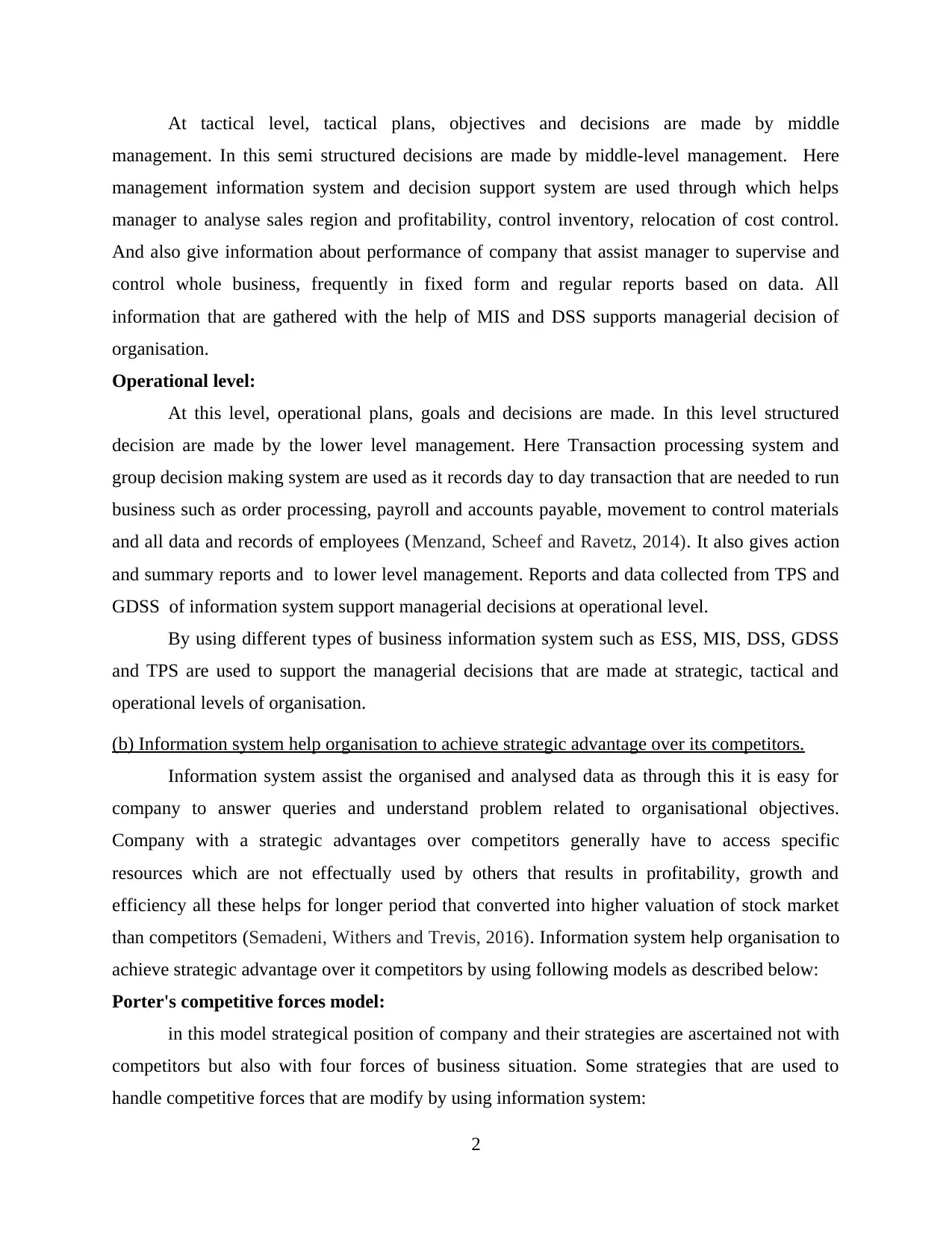
At tactical level, tactical plans, objectives and decisions are made by middle
management. In this semi structured decisions are made by middle-level management. Here
management information system and decision support system are used through which helps
manager to analyse sales region and profitability, control inventory, relocation of cost control.
And also give information about performance of company that assist manager to supervise and
control whole business, frequently in fixed form and regular reports based on data. All
information that are gathered with the help of MIS and DSS supports managerial decision of
organisation.
Operational level:
At this level, operational plans, goals and decisions are made. In this level structured
decision are made by the lower level management. Here Transaction processing system and
group decision making system are used as it records day to day transaction that are needed to run
business such as order processing, payroll and accounts payable, movement to control materials
and all data and records of employees (Menzand, Scheef and Ravetz, 2014). It also gives action
and summary reports and to lower level management. Reports and data collected from TPS and
GDSS of information system support managerial decisions at operational level.
By using different types of business information system such as ESS, MIS, DSS, GDSS
and TPS are used to support the managerial decisions that are made at strategic, tactical and
operational levels of organisation.
(b) Information system help organisation to achieve strategic advantage over its competitors.
Information system assist the organised and analysed data as through this it is easy for
company to answer queries and understand problem related to organisational objectives.
Company with a strategic advantages over competitors generally have to access specific
resources which are not effectually used by others that results in profitability, growth and
efficiency all these helps for longer period that converted into higher valuation of stock market
than competitors (Semadeni, Withers and Trevis, 2016). Information system help organisation to
achieve strategic advantage over it competitors by using following models as described below:
Porter's competitive forces model:
in this model strategical position of company and their strategies are ascertained not with
competitors but also with four forces of business situation. Some strategies that are used to
handle competitive forces that are modify by using information system:
2
management. In this semi structured decisions are made by middle-level management. Here
management information system and decision support system are used through which helps
manager to analyse sales region and profitability, control inventory, relocation of cost control.
And also give information about performance of company that assist manager to supervise and
control whole business, frequently in fixed form and regular reports based on data. All
information that are gathered with the help of MIS and DSS supports managerial decision of
organisation.
Operational level:
At this level, operational plans, goals and decisions are made. In this level structured
decision are made by the lower level management. Here Transaction processing system and
group decision making system are used as it records day to day transaction that are needed to run
business such as order processing, payroll and accounts payable, movement to control materials
and all data and records of employees (Menzand, Scheef and Ravetz, 2014). It also gives action
and summary reports and to lower level management. Reports and data collected from TPS and
GDSS of information system support managerial decisions at operational level.
By using different types of business information system such as ESS, MIS, DSS, GDSS
and TPS are used to support the managerial decisions that are made at strategic, tactical and
operational levels of organisation.
(b) Information system help organisation to achieve strategic advantage over its competitors.
Information system assist the organised and analysed data as through this it is easy for
company to answer queries and understand problem related to organisational objectives.
Company with a strategic advantages over competitors generally have to access specific
resources which are not effectually used by others that results in profitability, growth and
efficiency all these helps for longer period that converted into higher valuation of stock market
than competitors (Semadeni, Withers and Trevis, 2016). Information system help organisation to
achieve strategic advantage over it competitors by using following models as described below:
Porter's competitive forces model:
in this model strategical position of company and their strategies are ascertained not with
competitors but also with four forces of business situation. Some strategies that are used to
handle competitive forces that are modify by using information system:
2
Paraphrase This Document
Need a fresh take? Get an instant paraphrase of this document with our AI Paraphraser
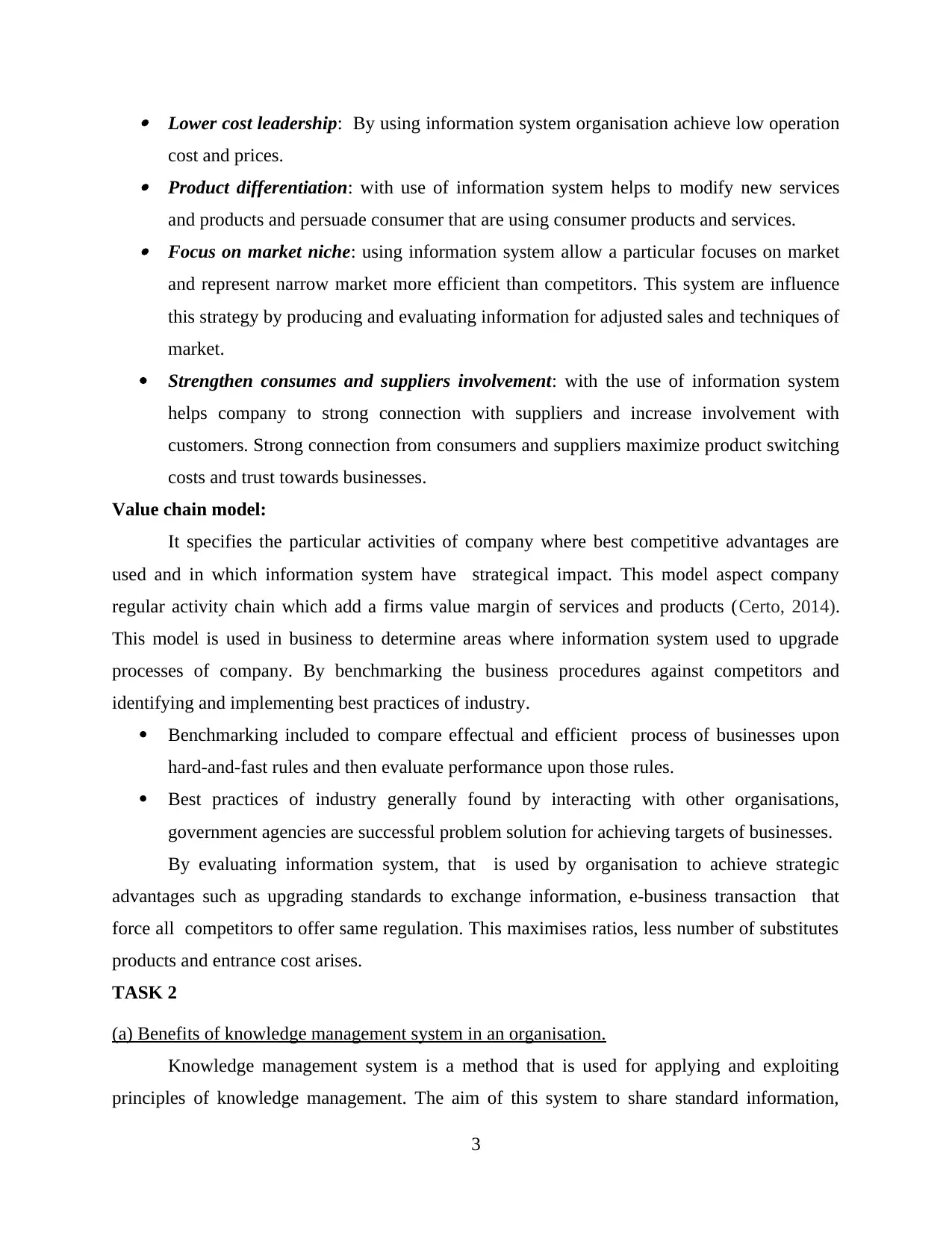
Lower cost leadership: By using information system organisation achieve low operation
cost and prices. Product differentiation: with use of information system helps to modify new services
and products and persuade consumer that are using consumer products and services. Focus on market niche: using information system allow a particular focuses on market
and represent narrow market more efficient than competitors. This system are influence
this strategy by producing and evaluating information for adjusted sales and techniques of
market.
Strengthen consumes and suppliers involvement: with the use of information system
helps company to strong connection with suppliers and increase involvement with
customers. Strong connection from consumers and suppliers maximize product switching
costs and trust towards businesses.
Value chain model:
It specifies the particular activities of company where best competitive advantages are
used and in which information system have strategical impact. This model aspect company
regular activity chain which add a firms value margin of services and products (Certo, 2014).
This model is used in business to determine areas where information system used to upgrade
processes of company. By benchmarking the business procedures against competitors and
identifying and implementing best practices of industry.
Benchmarking included to compare effectual and efficient process of businesses upon
hard-and-fast rules and then evaluate performance upon those rules.
Best practices of industry generally found by interacting with other organisations,
government agencies are successful problem solution for achieving targets of businesses.
By evaluating information system, that is used by organisation to achieve strategic
advantages such as upgrading standards to exchange information, e-business transaction that
force all competitors to offer same regulation. This maximises ratios, less number of substitutes
products and entrance cost arises.
TASK 2
(a) Benefits of knowledge management system in an organisation.
Knowledge management system is a method that is used for applying and exploiting
principles of knowledge management. The aim of this system to share standard information,
3
cost and prices. Product differentiation: with use of information system helps to modify new services
and products and persuade consumer that are using consumer products and services. Focus on market niche: using information system allow a particular focuses on market
and represent narrow market more efficient than competitors. This system are influence
this strategy by producing and evaluating information for adjusted sales and techniques of
market.
Strengthen consumes and suppliers involvement: with the use of information system
helps company to strong connection with suppliers and increase involvement with
customers. Strong connection from consumers and suppliers maximize product switching
costs and trust towards businesses.
Value chain model:
It specifies the particular activities of company where best competitive advantages are
used and in which information system have strategical impact. This model aspect company
regular activity chain which add a firms value margin of services and products (Certo, 2014).
This model is used in business to determine areas where information system used to upgrade
processes of company. By benchmarking the business procedures against competitors and
identifying and implementing best practices of industry.
Benchmarking included to compare effectual and efficient process of businesses upon
hard-and-fast rules and then evaluate performance upon those rules.
Best practices of industry generally found by interacting with other organisations,
government agencies are successful problem solution for achieving targets of businesses.
By evaluating information system, that is used by organisation to achieve strategic
advantages such as upgrading standards to exchange information, e-business transaction that
force all competitors to offer same regulation. This maximises ratios, less number of substitutes
products and entrance cost arises.
TASK 2
(a) Benefits of knowledge management system in an organisation.
Knowledge management system is a method that is used for applying and exploiting
principles of knowledge management. The aim of this system to share standard information,
3
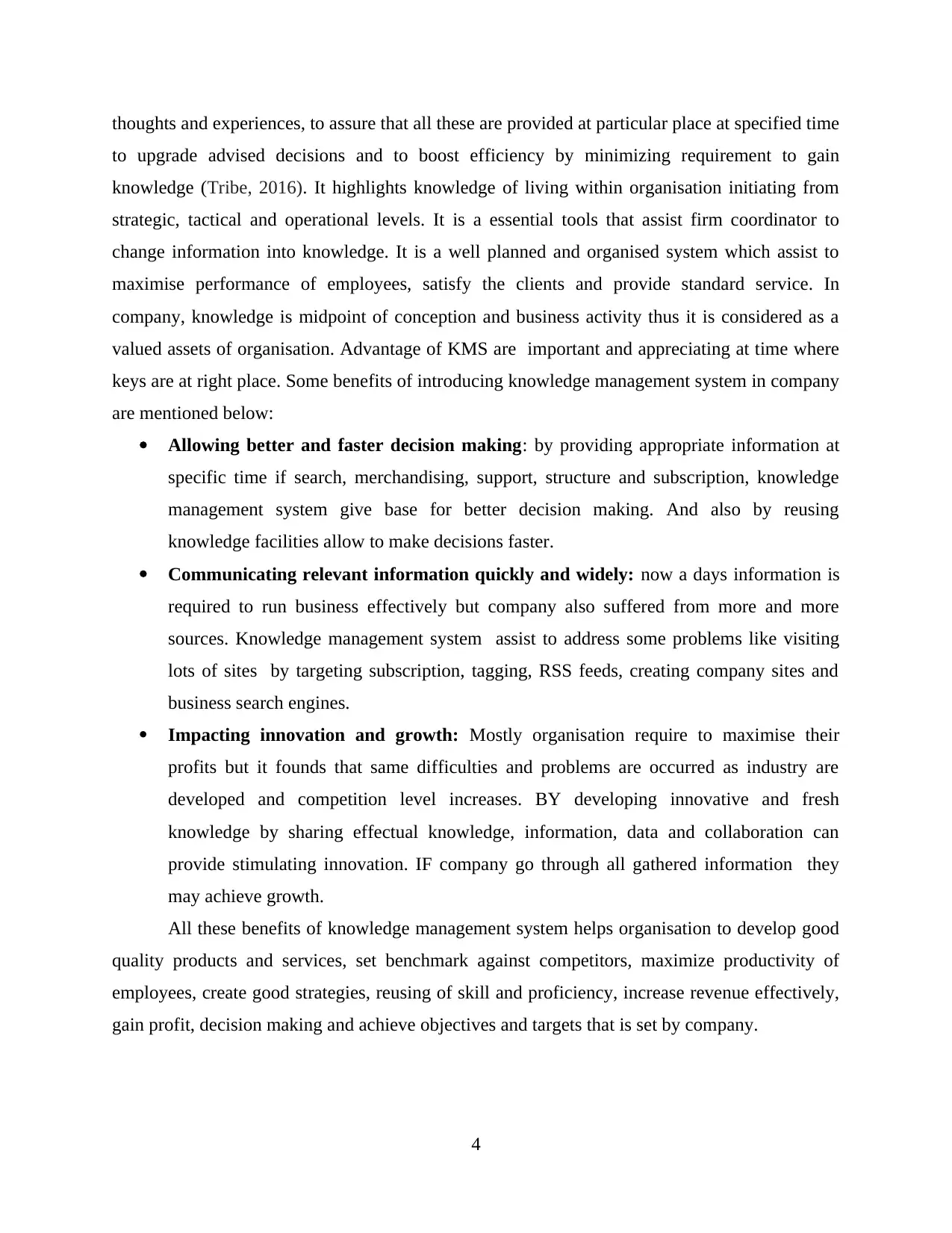
thoughts and experiences, to assure that all these are provided at particular place at specified time
to upgrade advised decisions and to boost efficiency by minimizing requirement to gain
knowledge (Tribe, 2016). It highlights knowledge of living within organisation initiating from
strategic, tactical and operational levels. It is a essential tools that assist firm coordinator to
change information into knowledge. It is a well planned and organised system which assist to
maximise performance of employees, satisfy the clients and provide standard service. In
company, knowledge is midpoint of conception and business activity thus it is considered as a
valued assets of organisation. Advantage of KMS are important and appreciating at time where
keys are at right place. Some benefits of introducing knowledge management system in company
are mentioned below:
Allowing better and faster decision making: by providing appropriate information at
specific time if search, merchandising, support, structure and subscription, knowledge
management system give base for better decision making. And also by reusing
knowledge facilities allow to make decisions faster.
Communicating relevant information quickly and widely: now a days information is
required to run business effectively but company also suffered from more and more
sources. Knowledge management system assist to address some problems like visiting
lots of sites by targeting subscription, tagging, RSS feeds, creating company sites and
business search engines.
Impacting innovation and growth: Mostly organisation require to maximise their
profits but it founds that same difficulties and problems are occurred as industry are
developed and competition level increases. BY developing innovative and fresh
knowledge by sharing effectual knowledge, information, data and collaboration can
provide stimulating innovation. IF company go through all gathered information they
may achieve growth.
All these benefits of knowledge management system helps organisation to develop good
quality products and services, set benchmark against competitors, maximize productivity of
employees, create good strategies, reusing of skill and proficiency, increase revenue effectively,
gain profit, decision making and achieve objectives and targets that is set by company.
4
to upgrade advised decisions and to boost efficiency by minimizing requirement to gain
knowledge (Tribe, 2016). It highlights knowledge of living within organisation initiating from
strategic, tactical and operational levels. It is a essential tools that assist firm coordinator to
change information into knowledge. It is a well planned and organised system which assist to
maximise performance of employees, satisfy the clients and provide standard service. In
company, knowledge is midpoint of conception and business activity thus it is considered as a
valued assets of organisation. Advantage of KMS are important and appreciating at time where
keys are at right place. Some benefits of introducing knowledge management system in company
are mentioned below:
Allowing better and faster decision making: by providing appropriate information at
specific time if search, merchandising, support, structure and subscription, knowledge
management system give base for better decision making. And also by reusing
knowledge facilities allow to make decisions faster.
Communicating relevant information quickly and widely: now a days information is
required to run business effectively but company also suffered from more and more
sources. Knowledge management system assist to address some problems like visiting
lots of sites by targeting subscription, tagging, RSS feeds, creating company sites and
business search engines.
Impacting innovation and growth: Mostly organisation require to maximise their
profits but it founds that same difficulties and problems are occurred as industry are
developed and competition level increases. BY developing innovative and fresh
knowledge by sharing effectual knowledge, information, data and collaboration can
provide stimulating innovation. IF company go through all gathered information they
may achieve growth.
All these benefits of knowledge management system helps organisation to develop good
quality products and services, set benchmark against competitors, maximize productivity of
employees, create good strategies, reusing of skill and proficiency, increase revenue effectively,
gain profit, decision making and achieve objectives and targets that is set by company.
4
⊘ This is a preview!⊘
Do you want full access?
Subscribe today to unlock all pages.

Trusted by 1+ million students worldwide
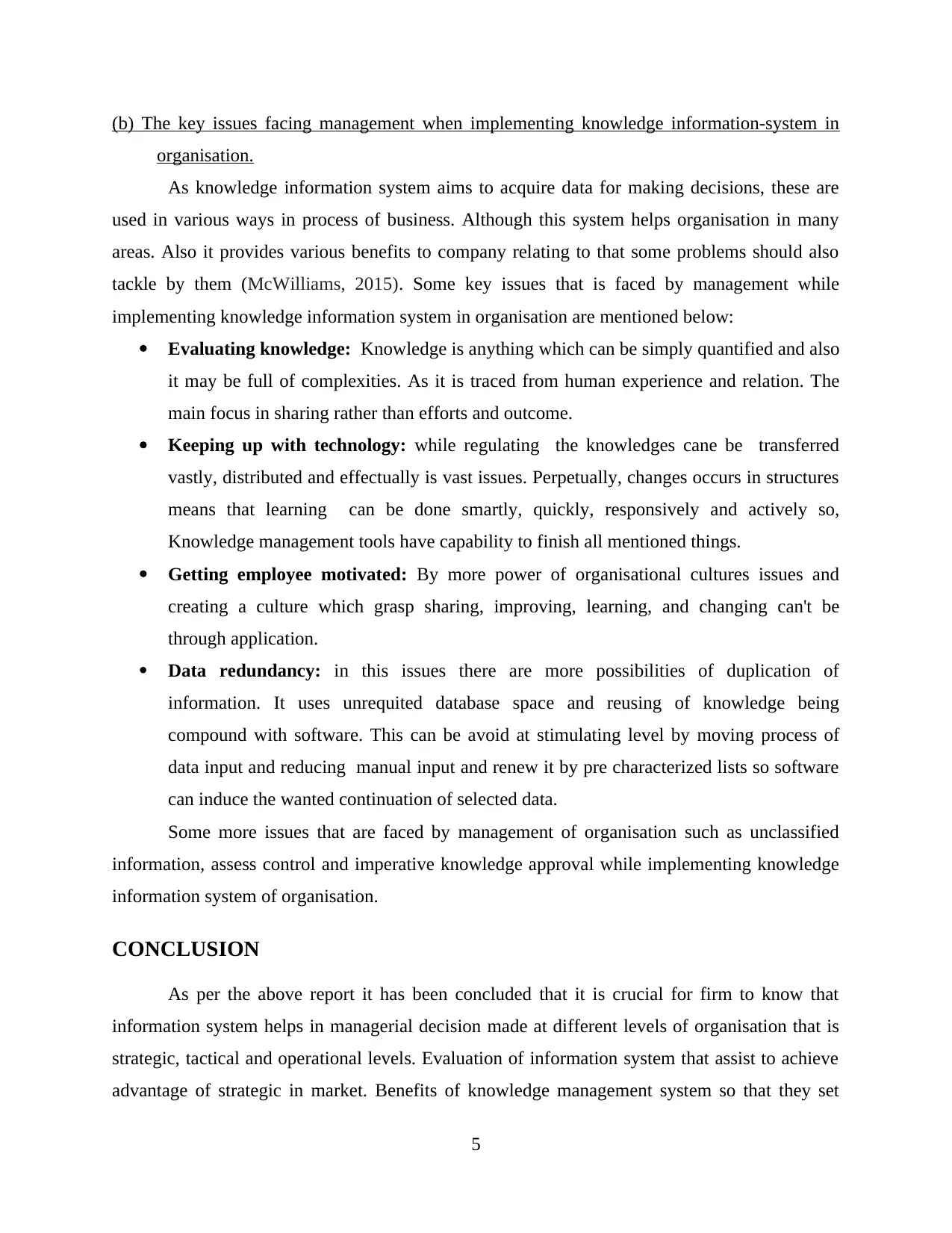
(b) The key issues facing management when implementing knowledge information-system in
organisation.
As knowledge information system aims to acquire data for making decisions, these are
used in various ways in process of business. Although this system helps organisation in many
areas. Also it provides various benefits to company relating to that some problems should also
tackle by them (McWilliams, 2015). Some key issues that is faced by management while
implementing knowledge information system in organisation are mentioned below:
Evaluating knowledge: Knowledge is anything which can be simply quantified and also
it may be full of complexities. As it is traced from human experience and relation. The
main focus in sharing rather than efforts and outcome.
Keeping up with technology: while regulating the knowledges cane be transferred
vastly, distributed and effectually is vast issues. Perpetually, changes occurs in structures
means that learning can be done smartly, quickly, responsively and actively so,
Knowledge management tools have capability to finish all mentioned things.
Getting employee motivated: By more power of organisational cultures issues and
creating a culture which grasp sharing, improving, learning, and changing can't be
through application.
Data redundancy: in this issues there are more possibilities of duplication of
information. It uses unrequited database space and reusing of knowledge being
compound with software. This can be avoid at stimulating level by moving process of
data input and reducing manual input and renew it by pre characterized lists so software
can induce the wanted continuation of selected data.
Some more issues that are faced by management of organisation such as unclassified
information, assess control and imperative knowledge approval while implementing knowledge
information system of organisation.
CONCLUSION
As per the above report it has been concluded that it is crucial for firm to know that
information system helps in managerial decision made at different levels of organisation that is
strategic, tactical and operational levels. Evaluation of information system that assist to achieve
advantage of strategic in market. Benefits of knowledge management system so that they set
5
organisation.
As knowledge information system aims to acquire data for making decisions, these are
used in various ways in process of business. Although this system helps organisation in many
areas. Also it provides various benefits to company relating to that some problems should also
tackle by them (McWilliams, 2015). Some key issues that is faced by management while
implementing knowledge information system in organisation are mentioned below:
Evaluating knowledge: Knowledge is anything which can be simply quantified and also
it may be full of complexities. As it is traced from human experience and relation. The
main focus in sharing rather than efforts and outcome.
Keeping up with technology: while regulating the knowledges cane be transferred
vastly, distributed and effectually is vast issues. Perpetually, changes occurs in structures
means that learning can be done smartly, quickly, responsively and actively so,
Knowledge management tools have capability to finish all mentioned things.
Getting employee motivated: By more power of organisational cultures issues and
creating a culture which grasp sharing, improving, learning, and changing can't be
through application.
Data redundancy: in this issues there are more possibilities of duplication of
information. It uses unrequited database space and reusing of knowledge being
compound with software. This can be avoid at stimulating level by moving process of
data input and reducing manual input and renew it by pre characterized lists so software
can induce the wanted continuation of selected data.
Some more issues that are faced by management of organisation such as unclassified
information, assess control and imperative knowledge approval while implementing knowledge
information system of organisation.
CONCLUSION
As per the above report it has been concluded that it is crucial for firm to know that
information system helps in managerial decision made at different levels of organisation that is
strategic, tactical and operational levels. Evaluation of information system that assist to achieve
advantage of strategic in market. Benefits of knowledge management system so that they set
5
Paraphrase This Document
Need a fresh take? Get an instant paraphrase of this document with our AI Paraphraser
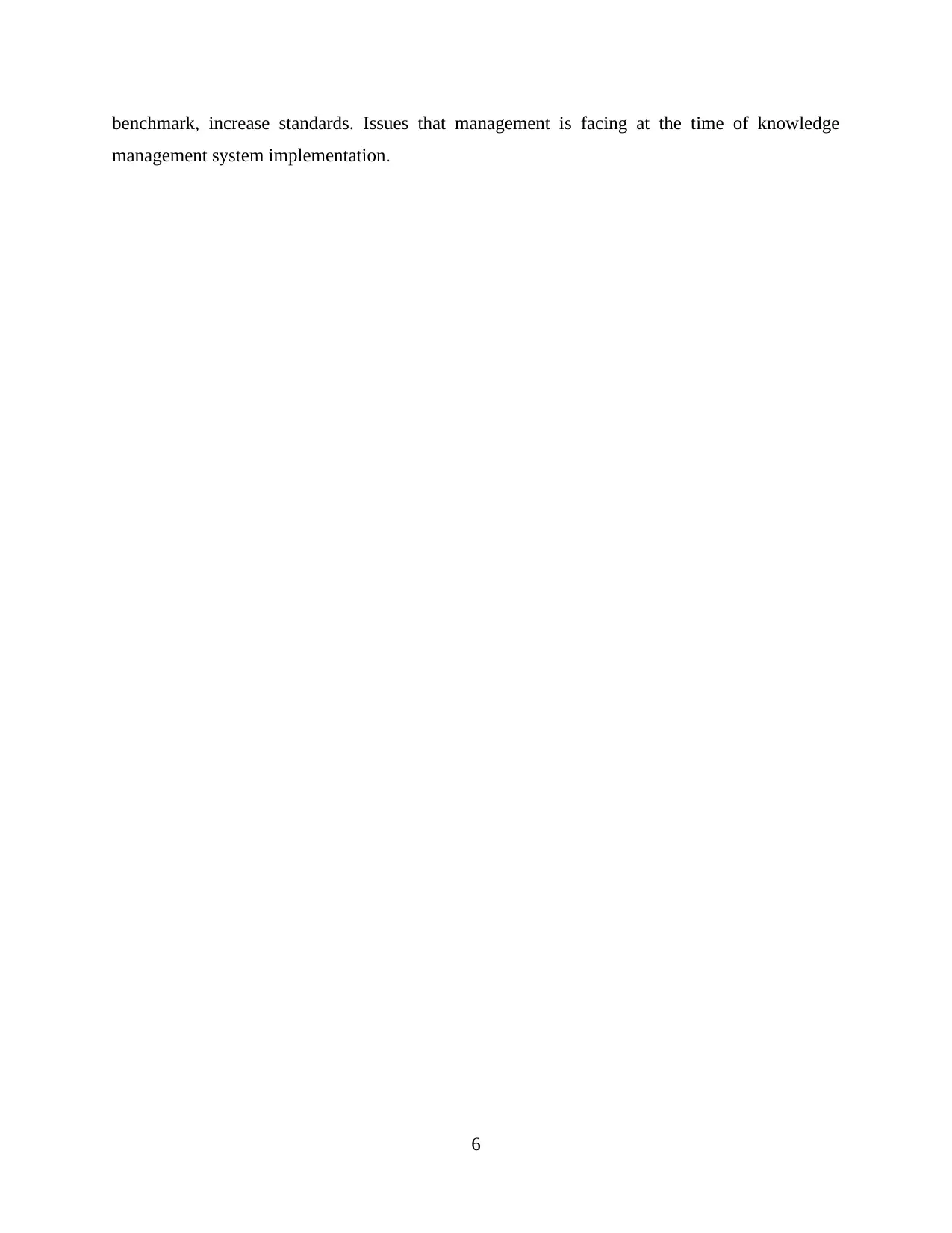
benchmark, increase standards. Issues that management is facing at the time of knowledge
management system implementation.
6
management system implementation.
6

REFERENCES
Books and Journals
Madsen, T. L. and Walker, G., 2015. Modern competitive strategy. McGraw Hill.
McWilliams, A., 2015. Corporate social responsibility. Wiley encyclopedia of management. pp.1-
4.
Menz, M. and Scheef, C., 2014. Chief strategy officers: Contingency analysis of their presence in
top management teams. Strategic Management Journal. 35(3). pp.461-471.
Ravetz, J., 2016. City-region 2020: integrated planning for a sustainable environment.
Routledge.
Semadeni, M., Withers, M. C. and Trevis Certo, S., 2014. The perils of endogeneity and
instrumental variables in strategy research: Understanding through simulations.
Strategic Management Journal. 35(7). pp.1070-1079.
Tribe, J., 2016. Strategy for tourism (No. Ed. 2). Goodfellow Publisher Limited.
Online
Business information system. 2018 [Online]. Available Through:
<http://aboutnigerians.com/what-is-a-business-information-system/>
7
Books and Journals
Madsen, T. L. and Walker, G., 2015. Modern competitive strategy. McGraw Hill.
McWilliams, A., 2015. Corporate social responsibility. Wiley encyclopedia of management. pp.1-
4.
Menz, M. and Scheef, C., 2014. Chief strategy officers: Contingency analysis of their presence in
top management teams. Strategic Management Journal. 35(3). pp.461-471.
Ravetz, J., 2016. City-region 2020: integrated planning for a sustainable environment.
Routledge.
Semadeni, M., Withers, M. C. and Trevis Certo, S., 2014. The perils of endogeneity and
instrumental variables in strategy research: Understanding through simulations.
Strategic Management Journal. 35(7). pp.1070-1079.
Tribe, J., 2016. Strategy for tourism (No. Ed. 2). Goodfellow Publisher Limited.
Online
Business information system. 2018 [Online]. Available Through:
<http://aboutnigerians.com/what-is-a-business-information-system/>
7
⊘ This is a preview!⊘
Do you want full access?
Subscribe today to unlock all pages.

Trusted by 1+ million students worldwide

REFERENCES
Books and Journals
Madsen, T. L. and Walker, G., 2015. Modern competitive strategy. McGraw Hill.
McWilliams, A., 2015. Corporate social responsibility. Wiley encyclopedia of management. pp.1-
4.
Menz, M. and Scheef, C., 2014. Chief strategy officers: Contingency analysis of their presence in
top management teams. Strategic Management Journal. 35(3). pp.461-471.
Ravetz, J., 2016. City-region 2020: integrated planning for a sustainable environment.
Routledge.
Semadeni, M., Withers, M. C. and Trevis Certo, S., 2014. The perils of endogeneity and
instrumental variables in strategy research: Understanding through simulations.
Strategic Management Journal. 35(7). pp.1070-1079.
Tribe, J., 2016. Strategy for tourism (No. Ed. 2). Goodfellow Publisher Limited.
Online
Business information system. 2018 [Online]. Available Through:
<http://aboutnigerians.com/what-is-a-business-information-system/>
8
Books and Journals
Madsen, T. L. and Walker, G., 2015. Modern competitive strategy. McGraw Hill.
McWilliams, A., 2015. Corporate social responsibility. Wiley encyclopedia of management. pp.1-
4.
Menz, M. and Scheef, C., 2014. Chief strategy officers: Contingency analysis of their presence in
top management teams. Strategic Management Journal. 35(3). pp.461-471.
Ravetz, J., 2016. City-region 2020: integrated planning for a sustainable environment.
Routledge.
Semadeni, M., Withers, M. C. and Trevis Certo, S., 2014. The perils of endogeneity and
instrumental variables in strategy research: Understanding through simulations.
Strategic Management Journal. 35(7). pp.1070-1079.
Tribe, J., 2016. Strategy for tourism (No. Ed. 2). Goodfellow Publisher Limited.
Online
Business information system. 2018 [Online]. Available Through:
<http://aboutnigerians.com/what-is-a-business-information-system/>
8
1 out of 10
Related Documents
Your All-in-One AI-Powered Toolkit for Academic Success.
+13062052269
info@desklib.com
Available 24*7 on WhatsApp / Email
![[object Object]](/_next/static/media/star-bottom.7253800d.svg)
Unlock your academic potential
Copyright © 2020–2025 A2Z Services. All Rights Reserved. Developed and managed by ZUCOL.




